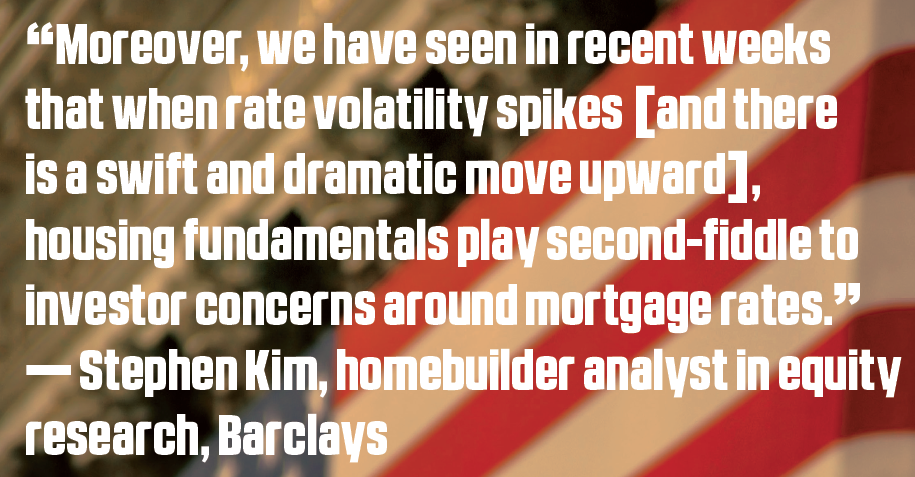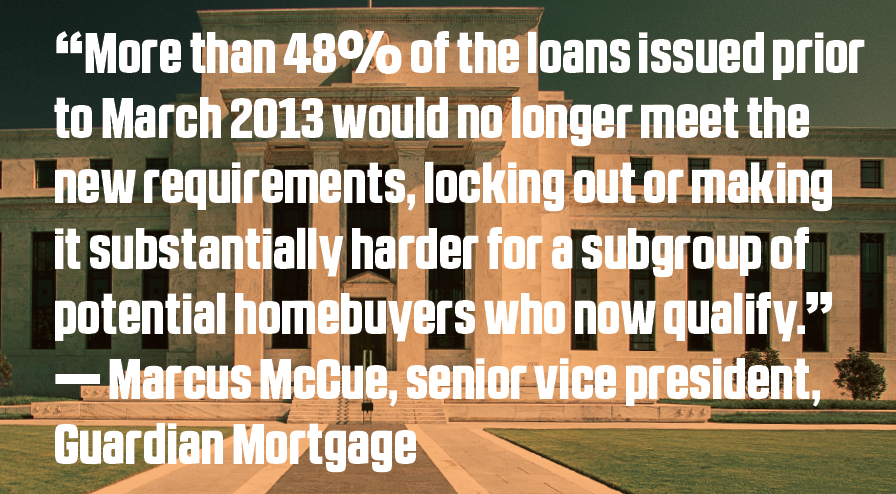In late June, the rally in the stock market came to a crashing halt. Jittery investors watched from the sidelines as their bearish side took control, unable to do anything but watch the New York Stock Exchange slip below 15,000 — victims of their own making.
Then almost as suddenly, the rally returned. Anchors on CNBC started smiling more. Stock market subject matter experts became willing to go back on network news.
Ladies and gentlemen, homebuilder Lennar Corp. handily beat earnings expectations by more than $0.10 per share. The housing recovery saves the day — again.
The nation’s economy has come to rely on the housing recovery. Without it, jobs don’t return, gross domestic product doesn’t grow and the Federal Reserve can’t hint that it may soon begin its withdrawal from quantitative easing. If anything were to threaten the housing recovery, the nation’s financials could face severe short-term disruptions.
So what is the biggest threat to this economic holy grail? The mortgage market.
There is growing evidence of an investor pullback from the housing market. Home price appreciation is beginning to dampen the cap rate for many private equity firms. Many are reaching the apex of their acquisition targets. There are still rampant anecdotes of the bank swooping in on the courthouse steps and overpaying for an REO, but these don’t represent critical mass in the space any longer.
Cash may have been king up until now, but as it leaves the market the question mark of whether or not mortgages can fill the gap becomes larger.
According to the latest Campbell/Inside Mortgage Finance HousingPulse Tracking Survey, the investor share of home purchases tumbled from 22% in April to 20.2% in May based on a three-month moving average.
“That was the sharpest drop in investor activity recorded in more than three years,” the report notes.
Current homeowners accounted for 43.8% of all home purchases in May while first-time homebuyer activity weighed in at 36%, HousingPulse results showed.
The Investor Traffic Index, an indicator of future home purchase activity, was down for three months in a row ending in May. In comparison, the Current Homeowner Index and First-Time Homebuyer Index both only started to seasonally ease downward in May.
COLLATERAL
The current and first-time homebuyer numbers should be viewed by collateral type. And when done so, their impact on the market-at-large appear much more limited.
According to the National Association of Realtors 2013 Profile of International Home Buying Activity survey — which asked Realtors to report their international business activity within the U.S. for the 12 months ending March 2013 — showed that total international sales stood at $68.2 billion, down approximately $14 billion from the previous year.
The decline was put down to a number of temporary factors, including economic slowdowns in a number of major foreign economies, tighter U.S. credit standards and unfavorable exchange rates. Of total international transactions, $34.8 billion (51%) were apportioned to foreign buyers with permanent residences outside the U.S. and $33.4 billion (49%) to buyers who were recent immigrants or temporary visa holders residing for more than half the year in the U.S.
“Foreign buyers are experiencing hurdles not only abroad, but also here in the U.S. when it comes to purchasing property,” said NAR President Gary Thomas, broker-owner of Evergreen Realty in Villa Park, Calif.
“Difficult economic conditions, particularly in Europe, have impacted foreign buyers, but several factors in the U.S. have also affected their purchasing power here. Tight credit standards have made financing challenging for immigrants, and low housing inventories have made finding a house difficult. However, none of these factors appear to be permanent.”
Anecdotal evidence on the ground in north Texas paints a picture that would seem to both support and undermine this mooted trajectory — albeit, allowing for regional variances.
“Foreign and domestic investors are dominating the housing market particularly at $350,000 and below, often offering sellers several thousands above asking price with all cash or conventional loans with heavy down payments,” said Christa Paulson, a real estate agent with the Jennifer Potter Group at Coldwell Banker Apex.
“I noticed that investors’ antennae picked up in the north Dallas area in the fourth quarter of 2012.” She believes the investor impact playing out in the area is positive — in the short term. “In some areas where sales had been stagnant, investor activity has provided renewed interest that has helped stabilize those markets and helped to preserve and even add value in these communities.”
But she pointed to recent activity where a buyer client who had failed with a bid on a home was recontacted by the seller after “contracts fell through due to the homes not appraising at the aforementioned increased offer prices.”
Which would seem to point back toward the importance of the grassroots: originations.
 FOREIGN INTEREST UNABATED
FOREIGN INTEREST UNABATED
But the long view offers a more transcendent picture, NAR found: That is, foreign buyers continue to have a substantial interest in U.S. properties. Over a five-year timeframe, more than 70% of Realtors reported a constant or increasing level in the number of international clients contacting them.
According to the NAR survey, five states accounted for 61% of the reported purchases: Florida with 23%; California at 17%; Arizona 9%; Texas 9%; and New York 3%. Somewhere in the region of half the foreign buyers preferred to purchase in a suburban area, while a quarter plucked for a more centralized urban area. A majority purchased a detached single-family home while 63% used all-cash, NAR continued.
Based on the reported international transactions, NAR said, the mean and median prices of purchases were higher when compared to purchase prices of domestic buyers. For the 12 months to March 2013, the median international home price was $275,862. For domestic buyers it was $179,867.
There were also style variations: The types of homes purchased by international buyers frequently tended to be different from the types of homes purchased by domestic U.S. buyers, NAR reported.
It must be noted that investors typically hover in the distressed space. Eventually, these homes will return to the market, creating more supply.
The real meat and potatoes in housing come from purchase mortgage originations. This relates to not just the first-time homebuyers but also the property ladder itself: the purchase of second and third homes. In other words: onward and upward, via the capital markets.
However, there is some volatility in home prices and mortgage rates that may keep potential homebuyers on the sidelines. For investors right now, this isn’t the problem.
“Moreover, we have seen in recent weeks that when rate volatility spikes [and there is a swift and dramatic move upward], housing fundamentals play second-fiddle to investor concerns around mortgage rates,” said Stephen Kim, homebuilder analyst in equity research at Barclays. “In short, common sense would dictate that when rates volatility subsides, housing fundamentals should drive investor behavior once again.”
Volatility is fine for investors, and more experts agree that these so-called fundamentals should provide a large deterrent.
“In our research, rates would have to rise another 2% and prices rise another 20% before prices become unaffordable,” read a recent tweet from the CoreLogic economics stream, widely believed to be directly authored by senior economist Sam Khater. Later, Khater would tweet more detail on what rate volatility is doing to the market.
“Since mid-May when mortgage rates on apps began to rise, the refi share fell from 76% to 67% and ARM share increased from 4% to 7% of apps,” the tweet read.
What the above numbers show is that while esoteric mortgage products are expanding marginally, more traditional and equally rate-sensitive products are contracting. The outlook is growing grim.
According to Amherst Securities Group, which monitors private-label securitization collateral performance, recent refinance opportunities are going from small to smaller. With a mortgage rate at least 50 basis points over a 4.67% interest rate, loans with a gross WAC of 5.17 would be considered “refinanceable,” versus 4.37 before the rate rise (3.87 rate + 50 basis points).
So, according to these numbers, of the 3.8 million loans in the nonagency market, only 291,000 met these criteria prior to the rate rise and only 272,000 afterward.
“It makes sense that the impact would be muted because there was little PLS [private-label securities] origination between 2007 and 2013, when interest rates were in the 4.5-5% range,” explained senior Amherst analyst Laurie Goodman.
Stewart Lender Services Group President Jason Nadeau touched on these concerns during a recent interview with HousingWire. “I think over the next couple of years as home prices pick up, everybody who has a mortgage is going to refinance at some point in time, if they have not already,” he said.
“I think we are going to see a decade of refinances in the teens from a percentage standpoint. I just don’t know who the new customers are … My concern is going to be that whenever refis drop, we’re not going to have enough purchases to replace it so the market as a whole is going to shrink and that will definitely affect us.”
Others are blunt on the prognosis.
“Housing, finance, mortgaging and the recovery in the U.S. will see a setback. How severe that setback will be remains to be seen. The range of outcomes may span several hundred thousand single-family housing starts a year. The news is not good. The economy is likely to slow because of the slowdown in the housing recovery,” wrote David Kotok, the chairman and chief investment officer of Cumberland Advisors in Business Insider.
In the article, Kotok essentially referred to the upcoming Qualified Mortgage and Qualified Residential Mortgage requirements coming from the Consumer Financial Protection Bureau.
“These new requirements, although designed to protect and treat all homebuyers equally and protect the industry from risky lending practices of the past, may actually eliminate lending options for a significant amount of otherwise qualified homebuyers,” Kotok warns.
And lenders are equally dour about the mortgage space. In their minds, they’ve already seen the results of flying fast and loose with underwriting. Their businesses are expanding. Lenders need to hire chief risk officers, something considered a wise investment. Companies such as SLS believe they can make inroads helping lenders achieve their goals, focusing on prime mortgage servicing, while allowing lenders to focus on homebuyers.
It should be a win-win, but the way mortgage regulations are going is creating a feeling that it can’t last much longer.
“More than 48% of the loans issued prior to March 2013 would no longer meet the new requirements, locking out or making it substantially harder for a subgroup of potential homebuyers who now qualify,” wrote Marcus McCue, a senior vice president of Plano, Texas-based Guardian Mortgage in a blog on HousingWire.com.
“We do believe there is going to be a slowdown,” said Doug Duncan, chief economist for Fannie Mae. Duncan noted that in 1994, for instance, rates rose 2% over a 12-month period, resulting in a huge impact on home prices, which fell significantly.
“If the rise happens rapidly, it tends to have an impact,” said Duncan, who added that once rates rise 100 basis points, home sales may begin to slow. As far as first-time homebuyers go, Duncan said it all depends on how high the mortgage costs go. “It’s all about the size of the mortgage that they’re going to try to take on relative to their financial strength,” said Duncan.
 INVESTOR-LED, INVESTOR-BLED
INVESTOR-LED, INVESTOR-BLED
Overall, first-time homebuyers are making up about 30% of total buyers, said Duncan. High investor activity is making up the difference, he added. “If investors fell off, would first-time buyers be bigger?” asked Duncan. A lot lies on that very important “if,” according to Duncan. As investors start to back out, prices will likely flatten out more. Meanwhile, the market will begin to slow.
So what to do? Blame mortgages for the housing slowdown, or at least the limited amount of mortgages available.
“Tight credit is limiting the ability of would be homebuyers to take advantage of today’s affordable conditions and likely discouraging many from even trying,” says Chris Herbert, director of research at the Joint Center for Housing Studies. “At issue is whether, and at what cost, mortgage financing will be available to borrowers across a broad spectrum of incomes, wealth and credit histories moving forward.”
From the lender’s point of view, moving to a purchase from a refinance market means capacity constraints are likely to ease, and lenders may be tempted to widen the credit box slightly, notes Amherst’s Goodman.
“That is, lenders will have the time and capacity to fully underwrite that marginal loan,” Goodman said. “This will have a marginal effect on net mortgage supply, not a strong one.”
As McCue noted in his blog, with a larger number of student debt-laden college graduates, self-employed and an increased number of immigrants, the cost limit on lower loan amounts and new 20% down payment requirements will change the face of the average homebuyer.
The American Dream of owning a home is going to disappear for many citizens of this nation, potentially taking the equally well-loved housing recovery with it.





